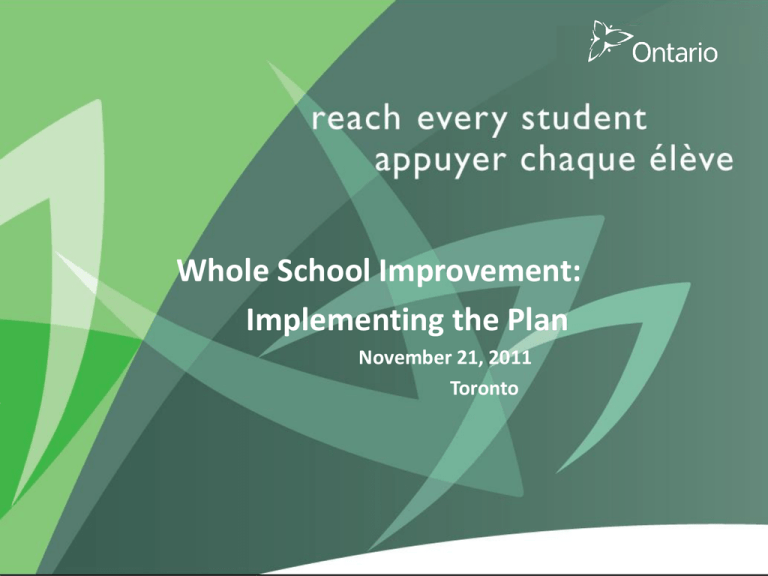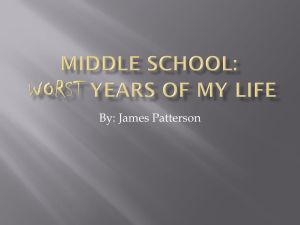PowerPoint for the Day (59 slides)
advertisement

Whole School Improvement: Implementing the Plan November 21, 2011 Toronto Session Goals • To examine and commit to effective instructional leadership practices that support whole school improvements in literacy and numeracy learning and achievement • To learn from and with each other and principals/teams from schools working in and with similar circumstances • To connect our individual and collective thinking during the session to the implementation of our school action plans • To expand networking among OFIP schools and build upon shared knowledge and common learning needs Opening Remarks Mary Jean Gallagher Chief Student Achievement Officer Student Achievement Division Assistant Deputy Minister of Education Whole School Improvement Planning Lucy West Creating Our Learning Community • • • • Taking a Learning Stance Being present Set a personal professional goal Share your goal with colleagues in a quick round robin • Listen for themes; notice differences • Allow the differences to be opening to possibilities What gets in the way? • Unwilling to admit we don’t know, pretense of knowing, need to look smart, confusing knowing with learning • Thinking I have to do it myself; not granting someone permission to teach us; unwilling to ask for help; confusing obedience/compliance with learning • End-gaming, no time, urgency What gets in the way? • Believing our reality is reality; unwilling to consider other perspectives • Taking the obvious/traditional as evidence—unwilling to question what is • Feeling overwhelmed, frustrated, impatient, anxious, distracted • Being in a hurry, no time, unable to prioritize what really matters What are your obstacles to learning? • Please identify at least two obstacles that might prevent you from learning today. • Share those two obstacles with a partner or two. • Consider what you might do to overcome your identified obstacles. Self-Awareness to Self-Management • Notice when you lose focus-- BREATHE AND REFOCUS • Notice when unclear, confused-- ASK • Notice when disagree—WONDER • Notice when taking things too seriously— PLAY • Notice when judging/blaming/comparing-EMPATHIZE Commitment to Learn • Identify one strategy/habit of mind you commit to practicing today. • Name it. • Describe it to a partner. • Ask your partner for specific assistance in attaining your goal. • Notice if you actually ask for help or not. Internal And External • Our individual learning obstacles are actually cultural—they are learned habits • How do they show up in our organizations—schools, boards, etc. • What is the cost of engaging in cultural norms that go against our professed goals? Failure is Essential • The important experiences are all the failures. • It is our errors and mistakes that give us the data we need to to learn and make changes that bring us to solutions. – Edgar Schein • What happens when people make mistakes in your school? Share The Problem to Invent the Solution • Requires relinquishing some authority • Requires accessing our ignorance • Requires renegotiation and willingness to be flexible • Requires trust and respecting others to have creative ideas and possible solutions • Requires moving from a “hero” or “expert” model to team models Teams • A team is defined by task interdependence (not motivation or intention). • A team is a number of people who are in a perpetual, mutual, helping relationship. • Do the adults in your school routinely help each other deepen their content knowledge and broaden their pedagogical repertoire? What are your guiding principles? • A consuming focus on instruction and evidence of learning worth learning (TASK) • Instructional change is a multi-stage process that takes TIME and practice (Three to ten years) Common Understanding • Time and again, educators meet to try to solve instructional problems without a common understanding of what they are trying to achieve in the classroom. Instructional Rounds in Education City, Elmore, Fiarman and Teitel Common Definition of “Look Fors” • It is now fairly typical for principals, coaches, and professional developers to periodically enter teachers’ classrooms for various purposes. It is not typical for these various parties to have a common definition of what they are looking for. Instructional Rounds in Education City, Elmore, Fiarman and Teitel Video 1 • Math Routine Pre-Kindergarten Class • How many milks do we need for 16 children? • What is the evidence that students are learning? • What are the essential characteristics of the teacher’s practice? What did you value? • Talk with your neighbors about what you valued in the video clips. • What do you wonder about and want more information about in relation to this class? • What judgments and conclusions did you come to based on 3 minutes of clips? Attendance Routine: Pre-kindergarten Teacher: Keshawn, How many milks do you think we'll need today for 16 children? Invitational. Keshawn: 4. T: You think we need 4, Keshawn? Affirming. K: Yeah. T: Why do you think we'll need 4 milks, Keshawn? Emphasis on communicating the reason underlying his choice. K: That will work. T: You think that will work? You think 4 milks will work? Revoicing. K: Yes. T: Come on over and let's get 4 milks. Let's see if 4 milks will work. Okay. Using his language, but posing a challenge to all the children. Attendance Routine: Pre-kindergarten T: 1, 2, 3, 4. Child: That not going to be enough. T: You don't think it will be enough? I've given Keshawn four milks. He thinks it will be enough for 16 children. Validating another child’s statement. Highlighting Keshawn’s original idea. Setting up a possible “mathematical” argument. Child: Ms. Jackson ...the number for milks and the number for children ... T: What happened? Question to help the child identify what’s problematic. K: It not enough. T: Four milks were not enough milks for 16 children. Restating to support language development and clarity of expression. Attendance Routine: Pre-kindergarten Child; Ms. Jackson ... T: Arkell didn't think it was going to be ... wait a minute, Fausto. Arkell didn't think it was going to be enough milks either. What should we do now, Keshawn? Question to support problem solving, but emphasizing that it’s the community’s problem also. K: Count them. D: Count what, Keshawn? What do you want us to count? Eliciting specificity. K: The milk that don't have milk. D: The children who don't have milks? Rephrasing to develop language and clarity. Attendance Routine: Pre-kindergarten Teacher: Herb? Herb: The number ... T: Do you think that will be enough? Focus is on thinking. H: The number for milks and the number for children are going to be the same. T: Say that again. I'm sorry. H: The number for milks and the number for children are the same. Video 2 • Turkey Problem--24 lb. Turkey--15 minutes per pound to cook--How long to cook the turkey? Video-Turkey Dinner • Grade 3—prior to any teaching of any multiplication algorithms • END of Lesson: Sharing student work after students have all solved the problem • Teacher deliberately determines the order in which selected partners will share. Compare the 2 Clips • What specific practices are common in both clips? • What must a teacher believe about learning and about children to behave in the ways these two teachers are behaving? • What skill set would a teacher need to have to teach content responsively rather than prescriptively? Adult Learning • What are the parallels between how these two teachers are orchestrating student learning with how leaders might orchestrate professional learning? • Orchestrating professional learning (in order to improve student learning) is the central focus of management. What is the essence? • Read the transcript—what specific “moves” is the teacher making to generate student discussion? • What role are the students playing? Turkey Problem • Dana: You guys, do you think you can come up and show what you did? And remember, try and explain it so we understand and then everybody else needs to listen carefully. And if you have questions or comments about Vicky or Amber’s work we can ask them when they’re finished explaining. (Dana sits with the children.) Setting clear expectations and giving the audience a role. Turkey Problem • • • • • D: And what is the 360? Amber: How long it… Vicky: 360 D: 360, and what does that mean, Vicky? Vicky: That means that it is … you have to… you have to let it cook for 360 minutes. • D: 360 minutes. Stays focused on the meaning of the answer Turkey Problem • D: 360 minutes. Who thinks they can explain how Amber and Vicky figured this out? What did they do? Rafe. Focusing students on each other’s thinking/listening • Rafe: They counted by 15s all the way up to 36 [sic]. • D: Can you tell from there (the chart) how many 15s? How many jumps of 15 they have to make? Focusing on making sense of the representation and meaning of the numbers • Rafe: 24, because I can see the number sentence. • D: And what did the number sentence say? • Rafe: 15 x 24 = 360. • D: Equals 360. Turkey Problem • • • • Rafe: 24, because I can see the number sentence. D: And what did the number sentence say? Rafe: 15 x 24 = 360. D: Equals 360. Turkey Problem • D: Equals 360. Nellie, did you have something to add? Facilitating talk among students • Nellie: Yeah. I know what they did, but there’s one thing that they didn’t figure out: how many hours 360 is. Student critiquing another student’s work Turkey Problem • D: How many hours 360 is. Without telling Victoria and Amber how many hours um 360 minutes is, can somebody give them a clue about how they might want to figure that out? How could they figure that out? Emma F? Giving the question to the students with constraints • Emma F.: I don’t know how to explain it, but….how did they know when to stop? • D: Well, that’s a great question. Fielding an uptake question Turkey Problem • Vicky: Because… • Amber: We counted 24 jumps. We counted 15, I mean 24 jumps. • D: You counted 24 jumps. OK. Did you understand that, Emma? How they did that … they counted each jump and they counted 24 times. (nod from Emma) Let’s get back to the clue. How could they figure out how many hours they have to cook that? Mackenzie, what do you think? Refocuses on previous question Additional Moves • Asks three different students to give clues—all three give similar clues in different ways. • Asks the presenting pair of students to go back and improve/complete their work. • Moves to a group that has a more sophisticated solution. Finding A Focus: Process • What are we looking for when we enter observe a lesson? • Student thinking is observable in two ways—orally and in writing. • Talk includes academic language or evidence of working toward us of language • Talk patterns include student-to-student exchanges Finding A Focus: Content • What is the nature and characteristics of the task students are being asked to do? • Authentic, worthy, relevant, rich, focuses on big ideas or essential questions, etc. • Do all students have entry AND is the sky the limit? • Even when working on a “skill” the focus is on making meaning through a search for pattern, use of structure. What are adults doing? • Routinely watching each other teach collaboratively planned lessons and providing focused feedback on shared practices (e.g. generating student discourse; focusing on big ideas) • Practicing using evidence of student learning as the focus of the observation, collecting verbatim notes to talk from. What are adults doing? • Non-defensively debriefing what happened in the classroom in relation to the process and content goals. • Reflecting on how to work with students who didn’t appear to understand and where to go next with kids who did • Refining the lesson to be used in the next class Instructional Leaders’ Roles • Create the structures and cultivate the environment of a learning culture • Provide myriad ways for various groups to meet around instruction and learning and attend some of these meetings • Provide coverage and opportunity for people to observe one another in the act of teacher and to then talk about it Instructional Leaders’ Roles • Stay focused for the long haul (3-5 years) • Involve teachers and other stakeholders in identifying the key 2-3 aspects of teaching and learning that will be the focus (e.g. 1 process and 1 content) • Visit classes to observe student learning when not “evaluating teachers” Turkey Problem • Lines 23-30 –seven student exchanges before Dana speaks again From Naming to Spreading Effective Instructional Practices • How did Dana and Diane learn to teach in a way that make student thinking visible? • What might the parallels be when Dana and Diane teach literacy? • How do we spread the work from one class to another? • How do we spread the work from one school to another? Multi-step Complex Process • Engaging all parties in learning—making CULTURE visible to transform it • Finding a high-leverage common focus— improving instruction • Creating a common understanding of effective instruction • Working on specific domino-effect aspects of instruction and gathering evidence Hierarchy of Interdependence – The biggest multiculturalism that is going to have to happen is within occupations rather than between nationalities—occupations are so rigid in how they prescribe how you are supposed to relate to everyone else. • Edgar Schein – We have a 19the century curriculum; a early 20th century structure, and are trying to accomplish 21st century goals Networking at the break … It’s Time to Talk to each other! Seven Corner Topics CORNER 1: Focus on mathematics. CORNER 2: Coordinate and strengthen mathematics leadership. CORNER 3: Build understanding of effective mathematics instruction. CORNER 4: Support collaborative professional learning in mathematics. CORNER 5: Design a responsive mathematics learning environment. CORNER 6: Provide assessment and evaluation in mathematics that supports student learning. CORNER 7: Facilitate access to mathematics learning resources. A numeracy lens … whole school improvement Seven Foundational Principles for Improvement in Mathematics, K - 12 • Number table participants 1 to 7 • Participants move to corner that has their number taking Seven Foundational Principles with them • Talking in groups of 2 or 3, discuss how the statements relate to the numeracy component of the school plan A literacy lens … whole school improvement Extend your thinking to include literacy: • Continue the discussion in the same group, discuss how the statements relate to the literacy component of the school plan • Conclude this conversation by discussing literacy and numeracy as part of integrated learning. Bringing the discussions together… • Return to table groups • Each participant shares two key learnings from their discussion corner • Whole group discussion Lunch Key Learning From The Morning • How did the work of the morning connect to your personal learning goal? • How do we build stamina and the will to persevere and what does this have to do with failure/mistakes? • What does respect have to do with sharing the problem, the teacher down the hall, and engaging rather than judging? • How do we connect values to actions — coherence? School Team Discussions Looking at the school plan and considering the conversations so far … • What questions or challenges are on your mind? • What areas of the plan do you see as well-positioned for moving forward as a whole school? Discussion Groups • • Teachers Administrators • System Roles • Supervisory officers • Share a question/challenge and an area positioned for success Bringing the conversation together … reflecting on moving forward • Return to home tables to share role conversations with full table team • As individual school teams work together to respond to Reflecting on the Day and Moving Forward Connecting the Day … Lucy West and Mike Jancik Final Points • Summary of the day’s learning • Expenses Have a safe trip home … the learning journey continues. Videos can be purchased from Heinemann: • Fostering Students Mathematical Development K-2 (Kindergarten clip) • Turkey Investigations, Grades 3-5 (Resource Package) • Antonia Cameron, City College of New York, Maarten Dolk, Freudenthal Institute, The Netherlands, Catherine Twomey Fosnot, City College of New York, Sherrin B. Hersch, City College of New York • These products are part of the series: The Mathematicians at Work Series Young










